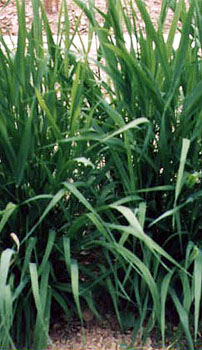
|
|
| Phalaris arundinacea - Red Canary Grass - Graminaea - Cosmopolitan |
|
Phalaris arundinacea (Red canary grass): This perennial is a native of Canada, but occurs in northern Europe and the northern half of the US. In the wild, it is usually found where there is purple loosestrife. It can grow over 6 feet tall and tends to form clumps. Fond of wetlands, it has been used in areas set up to filter sewage, but it also enjoys uplands and can survive drought. It grows best on moist, sandy soil and dislikes heat (won't prosper in the Deep South). An aggressive plant, some consider it a weed, others an excellent forage crop. It reproduces through its rhizomes or through its copious seeds. The plant has recently been discovered to have high concentrations of DMT, beta-carbolines, 5-MEO-demethyltryptamine, and trace amounts of bufotenine. Phalaris aquatica (P. tuberosa; Harding grass): A perennial grass that tends to grow along rivers and creek banks. Like P. arundinacea, this phalaris grows from rhizomes (looks like a thick root found near the surface of the soil) and can form thick tussocks. It was introduced to the US from Australia as a forage plant for sheep and has become naturalized in California. Keeping the plant cut will increase its spread horizontally. This plant also contains high concentrations of DMT, 5-MeO-DMT, bufotenine (in fresh but not dried plants), and beta-carbolines. Alkaloid content is increased when the plant is stressed, especially if it wilts (without dying), but as with all the phalaris, alkaloid content can vary not only from season to season but from plant to plant. WARNING: This strain is the one responsible for causing "Sheep Staggers" in grazing sheep. On the other hand, there hasn't been a single death or case of "Sheep Staggers" associated with Phalaris arundinacea. Please read the related article below. Growing Phalaris arundinacea: Just barely cover seeds or merely press into moist soil. Keep moist and at 41F/5C, if possible—the cooler, the better. It naturally germinates in early spring. Like all wild grasses, the germination of this seed is irregular; not all the seed will germinate at once, as happens with cultivated plants. Transplant to sandy soil and full sun. Once it is established, it grows from creeping rhizomes, which begin developing after a month of growth. It often grows in low-lying and marshy meadows and pastures that flood, but it is moderately drought resistant. It does well in fertile soils and humid areas, but it does not like subtropical or tropical climates. Growing Phalaris aquatica: Barely cover seeds (or simply press into moist soil) and keep at 70F for germination in 7-14 days. Grow on in cooler temperatures, preferably 60F, and full sun. This seed germinates over a wide period in order to have more survivors, so not all seed germinates at once. |
|
Related
Articles :
|
|
| Email
This Article To A Friend - Print
This Article Articles can be E-mailed to a friend and you can get a printable version of the article IMPORTANT: We provide all information for educational purposes only, and endorse or recommend nothing here. A special thanks to Keith for all his support and insight. |
|
